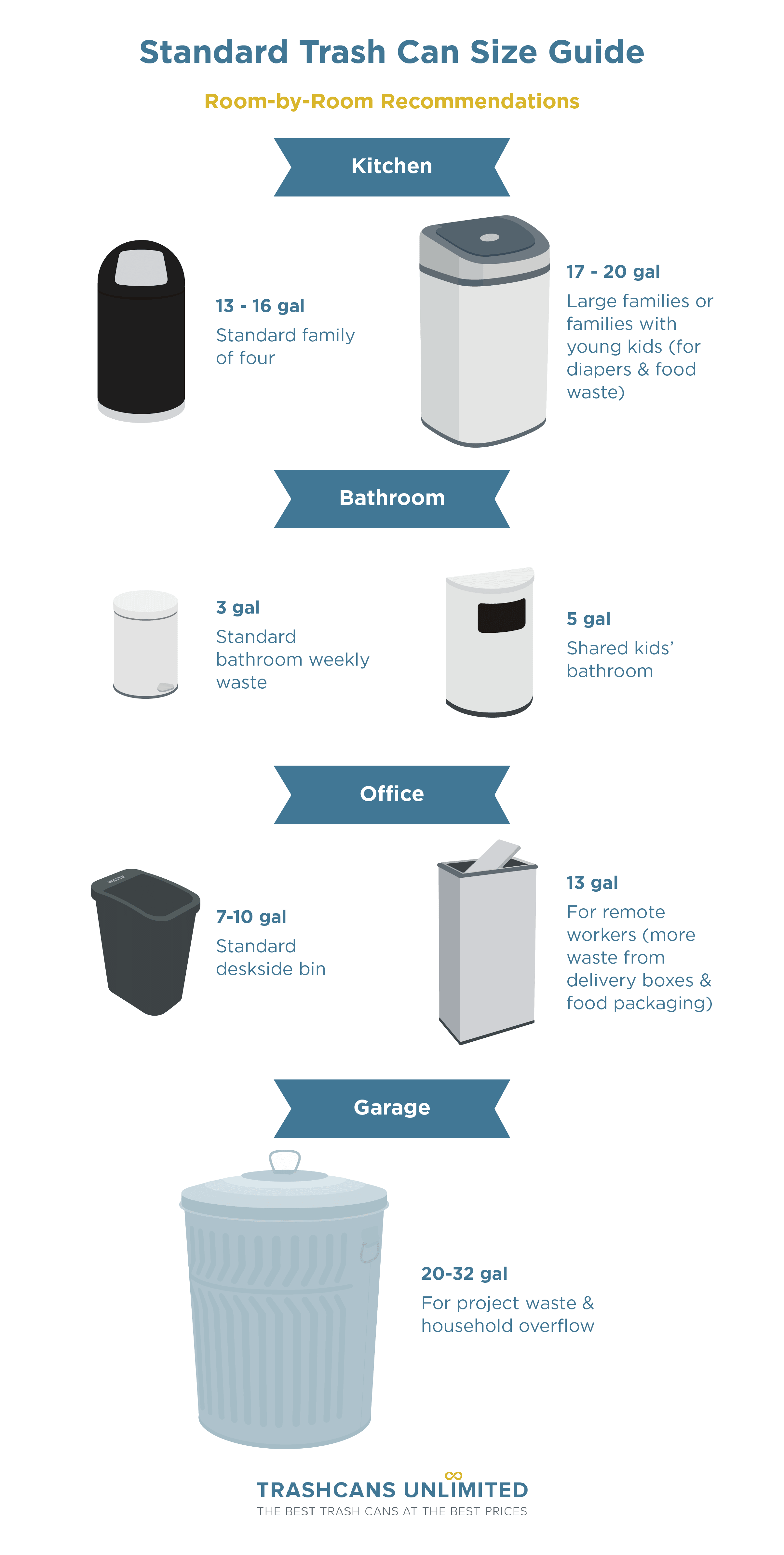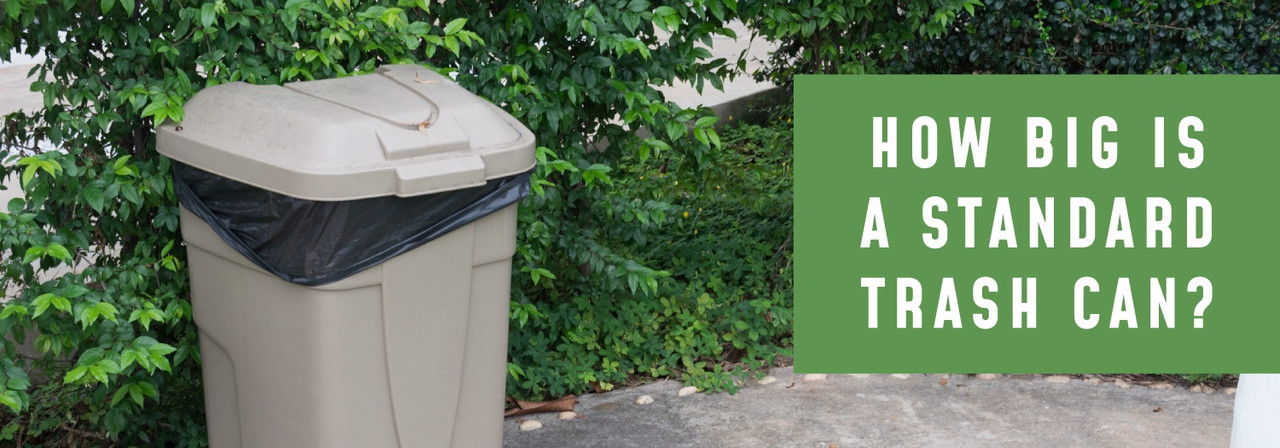Originally posted on 24th Sep 2024
The standard 13-gallon kitchen trash can measures 24" H × 16" W × 13" D—but that's only part of the story. Your under-sink cabinet, bathroom corner, office nook, and outdoor collection point each demand different dimensions. This trash can dimensions guide translates gallon capacities into exact measurements, so you'll buy the right size the first time.
Key Takeaways
- A standard kitchen trash can is typically 13 gallons, with dimensions around 24–26 inches in height, 15 inches wide, and 12 inches deep for rectangular models, fitting under most sinks and aligning with standard tall kitchen bags.
- For bathrooms, the standard size is 3 gallons, measuring approximately 12 inches high and 10 inches wide, suitable for weekly waste in limited spaces. In offices, 7–10 gallon bins are standard, with a maximum width of 12 inches to fit between desks.
- Garage or utility areas require larger bins, typically 20–32 gallons, with 32-gallon models being common for project waste and overflow, measuring up to 36 inches tall and 20 inches wide.
Understanding Trash Can Dimensions: The Real Numbers Behind Gallon to Size Conversion
A trash can's gallon rating tells you volume, but dimensions determine fit. That 13-gallon "standard" kitchen bin? It needs adequate vertical clearance once you factor in the lid mechanism. Miss this detail, and you're returning it tomorrow.
The relationship between gallons and inches follows a predictable pattern for standard trash can sizes. One gallon equals 231 cubic inches, but manufacturer shapes create surprising variations. A round 10-gallon bin stands 20 inches tall with a 15-inch diameter. The rectangular version? Same capacity at 18 inches tall but only 14 inches wide and 11 inches deep. That two-inch height difference determines whether it fits under your sink.
Standard Residential Trash Can Sizes: Room by Room Dimensions Guide
Kitchen Trash Cans: Finding Your Sweet Spot
Your kitchen trash can typically lives in the 10-16 gallon range, physically translating to 20-30 inches of height. The gallon ratings translate to practical realities:
The 10-gallon option (18-20" tall × 15" diameter) works for couples who eat out frequently. Rectangular 10-gallon models measure approximately 14.9" × 17.2" × 25.5", holding roughly three days of light cooking waste—perfect if you're emptying it twice weekly. The footprint fits 80% of apartment kitchen cabinets, making it the default urban choice.
The 13-gallon size (24-26" tall × 16" diameter) hits the sweet spot for families of four. Specific models measure 16 3/8" L × 12 5/8" W × 24 3/4" H, perfectly matching standard tall kitchen bags and holding four days of meal prep waste. At 15 inches wide and 12 inches deep in rectangular form, it slides into standard cabinet openings while leaving room for plumbing.
Step up to 20 gallons (30" tall × 18" diameter), and you're entering household-of-six territory. This size demands reinforced construction—you're looking at 50 pounds when full. The rectangular version measures 16" × 14", still manageable for most kitchens but requiring dedicated floor space rather than cabinet concealment.
Bathroom Bins: Small Space Solutions
Bathroom bins cluster in the 2-5 gallon range, measuring 10-15 inches tall. The most popular size is 3 gallons (12" H × 10" W)—large enough for a week's worth of bathroom waste, small enough to tuck beside any toilet.
Pedestal sinks change everything. You need the 2-gallon profile (14" H × 8" W) to maintain the required 27-inch knee clearance. Wall-mounted options solve floor space issues entirely—mount them 15-20 inches from the floor for comfortable access.
Outdoor Collection: Municipal Standards
Municipal bins come in three standard trash can sizes, each with a specific purpose:
- 32 gallons (36" H × 22" diameter): Single-person households or dedicated recycling
- 64 gallons (42" H × 24" W × 27" D): Standard for weekly collection, handles 30-35 bags annually
- 96 gallons (45" H × 26" W × 34" D): Bi-weekly collection for large families
That 64-gallon bin represents the industry standard for good reason. The 64-gallon cart has a load limit of 225 pounds, but remains wheelable even when approaching capacity. The 96-gallon option can exceed 150 pounds when full, pushing the limits of single-person maneuverability.
Complete Gallon to Size Conversion Chart
These exact trash can dimensions eliminate guesswork:
10-gallon bins
- Round: 18-20" tall × 15" diameter
- Rectangular: 18" tall × 14" wide × 11" deep
- Actual capacity: 2,310 cubic inches
- Full weight: 25 pounds maximum
- Ideal for: 80% of apartment kitchens, most bathroom vanities
13-gallon bins
- Round: 24-26" tall × 16" diameter
- Rectangular: 24" tall × 15" wide × 12" deep
- Actual capacity: 3,003 cubic inches
- Full weight: 35 pounds
- Ideal for: Under-sink cabinets need at least 30 inches of height clearance
20-gallon bins
- Round: 30" tall × 18" diameter
- Rectangular: 30" tall × 16" wide × 14" deep
- Actual capacity: 4,620 cubic inches
- Full weight: 50+ pounds (wheels recommended)
- Ideal for: Dedicated floor space, not cabinets
32-gallon bins
- Round: 36" tall × 22" diameter
- Rectangular: 36" tall × 20" wide × 16" deep
- Actual capacity: 7,392 cubic inches
- Full weight: 70 pounds
- Ideal for: Garages, utility rooms, outdoor spaces
64-gallon bins
- Standard: 42" tall × 24" wide × 27" deep
- Actual capacity: 14,784 cubic inches
- Full weight: 100-120 pounds
- Ideal for: Standard residential driveways and collection points
96-gallon bins
- Standard: 45" tall × 26" wide × 34" deep
- Actual capacity: 22,176 cubic inches
- Full weight: 150+ pounds
- Ideal for: Large families with 48" gate width for passage
Selecting the Right Trash Can Size: Room-by-Room Recommendations

Kitchen Command Center
Start with household size, then adjust for reality. A family of four typically needs 13-16 gallons for weekly emptying. If you work from home, add 20% capacity. Have kids under five? Add 30%—diapers and food waste pile up fast.
The composting factor changes everything. The EPA reports that food waste composting diverted only 5% of the 66.2 million tons of wasted food in 2019, but active home composters can achieve much higher diversion rates, allowing them to downsize their main trash can accordingly.
Bathroom Logistics
The 3-gallon size handles standard bathroom waste for a week, but feminine hygiene products typically demand minimum 3-gallon capacity with a closing lid. Guest bathrooms can survive with 2 gallons. Jack-and-jill bathrooms shared by kids? Consider going straight to 5 gallons.
Step-cans matter more in bathrooms than anywhere else. The soft-close mechanism provides 3 a.m. courtesy. Budget 3-4 inches of overhead clearance for the lid arc.
Office Calculations
Deskside bins typically need 7-10 gallons for a standard work week. The key dimension: 12-inch maximum width to fit between desks and file cabinets. The average office worker generates about two pounds of paper and paperboard products daily and uses roughly 10,000 sheets of copy paper annually.
Remote workers face unique waste challenges—all those delivery boxes and lunch packaging add up. Plan accordingly with a 13-gallon kitchen placement rather than a 7-gallon office bin.
Garage and Utility Zones
These spaces typically demand 20-32 gallons minimum. Project waste comes in bursts—one weekend of garage cleaning fills a 20-gallon bin instantly. The 32-gallon size handles ongoing projects plus household overflow.
Temperature swings matter here. HDPE plastic remains intact at temperatures from -50°C (-58°F) to 50°C (122°F), with the ability to tolerate spikes up to 80°C (176°F). Cheaper materials crack in winter and warp in summer. Sealed lids become essential for pest prevention in unconditioned spaces.
Matching Size to Space and Usage: Practical Formulas
Small Apartment Optimization
Slim profile 10-13 gallon bins with 8-12 inch width footprints maximize corners. D-shaped bins optimize wall placement while maintaining full access—they hug walls while preserving capacity.
Dual-compartment 16-gallon units (8 gallons per side) integrate recycling without doubling floor space. The divider runs lengthwise, creating two 12" × 6" openings—perfect for sorting at the source.
Under-Sink Installation Reality
That space under your sink requires careful measurement:
- Garbage disposal steals 6 inches from center
- P-trap eliminates 4-6 inches of depth
- Door hinges require 2 inches clearance
- Reality: 13" wide × 18" tall × 10" deep usable space
Most under-sink cabinets measure 30 inches tall, so your trash can needs to be shorter than that to leave room for throwing trash in. Pull-out systems solve the puzzle but require properly rated drawer slides for heavier capacities.
High-Traffic Area Specifications
Areas with 10+ daily users typically need 20-30 gallon capacity with hands-free operation. The foot pedal must withstand heavy use—residential-grade pedals fail quickly in commercial settings. The lid should open to 75 degrees minimum for unobstructed dumping.
Sensor-activated lids eliminate contact entirely but add 4 inches to height requirements and require regular battery maintenance. The trade-off: significant reduction in contact points during flu season.
The Household Calculation That Works
Base formula: 5-7 gallons per person per week. Then adjust:
- Home workers: +20%
- Families with babies: +30%
- Heavy cookers: +25%
- Composters: -35%
A family of four who cooks daily needs: 4 people × 6 gallons × 1.25 (cooking factor) = 30 gallons weekly. Split between a 13-gallon kitchen bin (emptied twice weekly) and a 32-gallon garage overflow, and you've solved the puzzle.
Key Measurement Considerations
Bag Compatibility Requirements
Your bin dimensions mean nothing if bags don't fit. Standard tall kitchen bags (13 gallon) measure 24" × 30" flat. They need a 15-inch diameter round opening or 12" × 12" square minimum. Force a bag into a smaller opening? You're fighting it every time you change bags.
Contractor bags (42 gallon) need appropriate opening diameter for proper fit. They're meant for 32-gallon bins and larger. Using kitchen bags in outdoor bins wastes 40% of the bin's capacity.
Weight Reality Check
Full trash cans become immovable objects:
- 10 gallons = 25 pounds (one-hand carry possible)
- 13 gallons = 35 pounds (two hands required)
- 20 gallons = 50 pounds (dragging begins)
- 32+ gallons = Don't even try lifting
This explains why 20-gallon bins mark the wheeled-base threshold. Your back will thank you.
Clearance Mathematics
The bin height isn't the number that matters. Real clearance requirements:
- Swing-top lids: Height × 1.4
- Step-cans: Height × 1.15
- Pull-out drawers: Depth × 2
- Sensor lids: Height + 4 inches
That 24-inch under-sink space? A 20-inch bin with step-lid barely fits once opened. The swing-top won't work at all.
Shape Advantages to Consider
Rectangle bins maximize corner space efficiency through simple geometry. D-shaped bins balance capacity with easy bag installation, offering a practical middle ground.
In tight spaces, shape matters more than size. A 10-gallon rectangular bin often works better than a 13-gallon round one because it uses corner space efficiently.
Making Your Decision
Stop guessing. Measure your space, calculate your weekly waste (5–7 gallons per person, adjusted for lifestyle), then match to these exact dimensions. The 13-gallon kitchen standard works for many households, but yours might need something different. Your perfect trash can exists—it’s just a matter of knowing the numbers before you buy.
Remember: you’re not just buying gallon capacity—you’re buying dimensions that fit your space and a weight you can manage comfortably. Get both right, and your daily cleanup becomes effortless. Get either wrong, and you’ll find yourself constantly frustrated. The investment in proper measurement pays dividends in daily convenience.
Whether you’re outfitting a compact apartment kitchen or managing family waste in a large home, accurate sizing ensures long-term satisfaction and functionality.
Ready to find the perfect fit? Explore our complete range of kitchen, bathroom, office, and outdoor trash cans in every size at Trashcans Unlimited. Our selection includes durable, stylish bins from top brands backed by full manufacturer warranties. Shop now to get reliable, lasting solutions for your home or business waste management needs.

